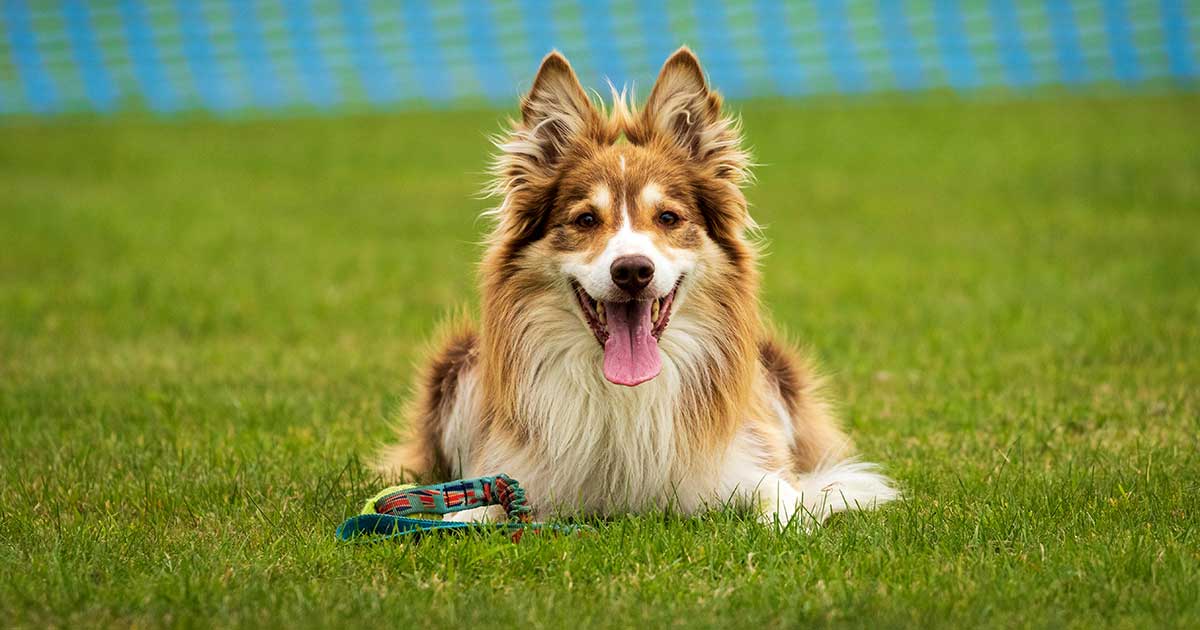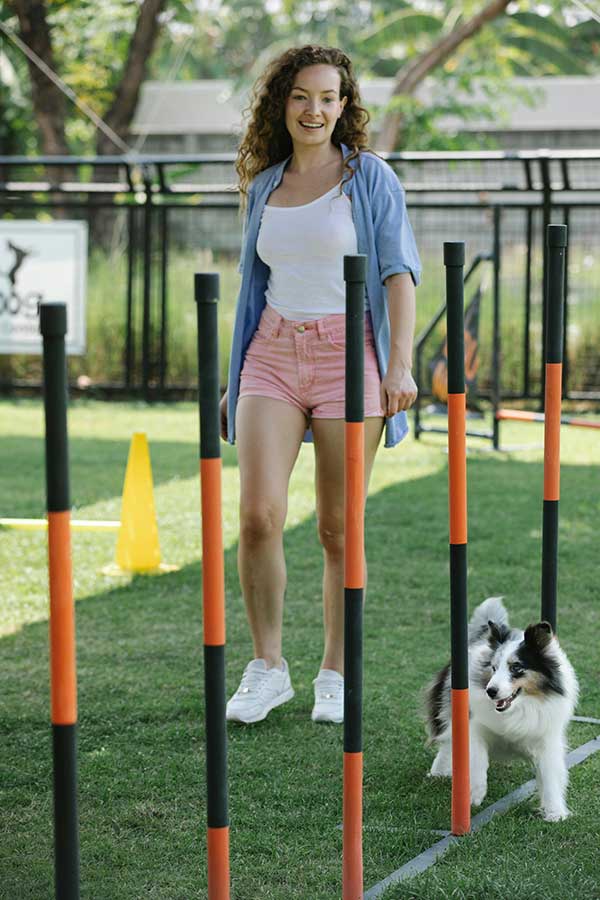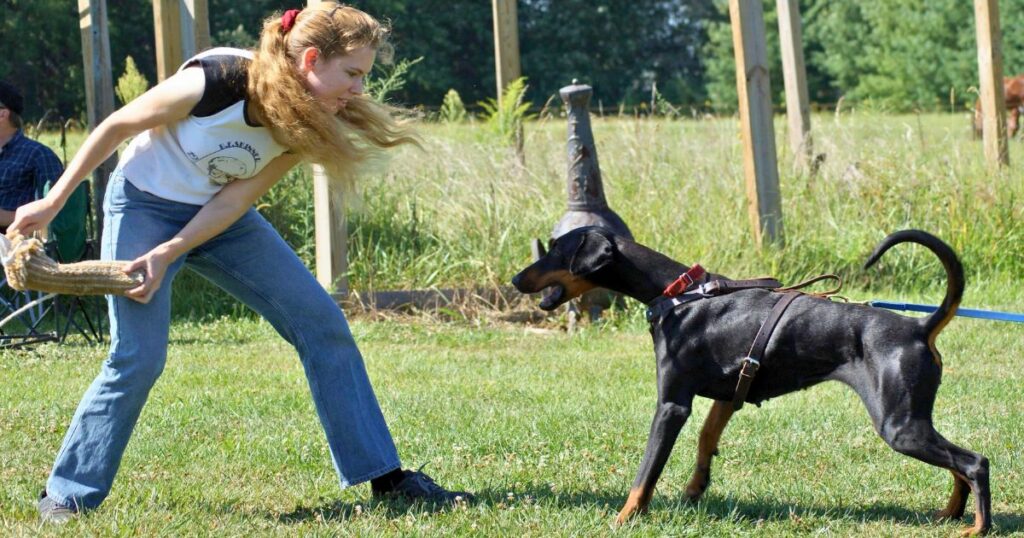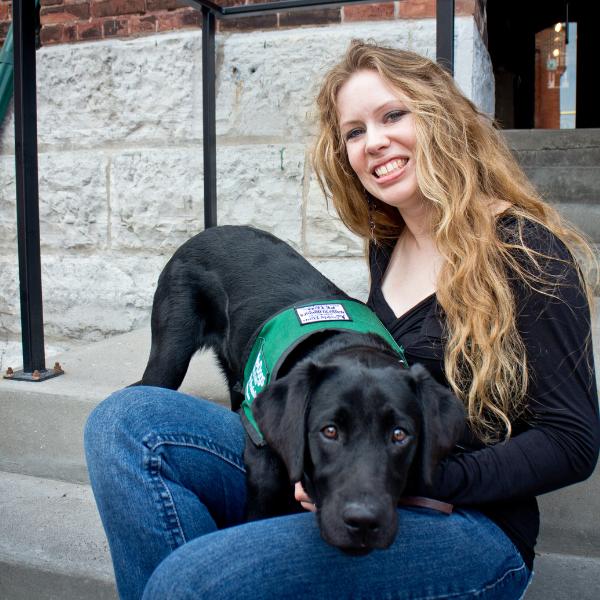
What’s missing?
“I don’t even know where to start. It just seems so huge and daunting. I don’t know how to define a plan, what steps to include, or when to raise criteria. It’s just easier to go out and do something, muddle around. I know that’s not efficient, but at least it’s something.”
This was the answer I heard when I asked a training partner why she didn’t have a training plan. Unfortunately, her response is not unique; I talk to a lot of trainers without a concrete training plan.
I was one of them once. I didn’t need a plan—I knew what I wanted! However, once I started really tracking criteria and success ratios, I saw my training leap forward and gain momentum. Instead of needing weeks or months to train a behavior, I needed days. It was marvelously exhilarating.
Now, I nearly always have a training plan when I begin a formal session with a dog. Sometimes it’s written, sometimes it’s not—but it’s always there in my mind. If the behavior is complex or critical, I do keep written records of criteria and success. I want to identify any trouble spots easily and fix them instantly instead of fumbling with a bothersome behavior for a long time. Two minutes of training with a solid plan is equivalent to at least twenty minutes without, in my judgment.
But how do you approach designing a training plan? This can be a daunting task for beginners.
Set a goal
The first step is to determine what it is you really want to train. This may sound foolish, but it’s actually neglected by many! “I want to teach my dog to heel,” someone might say. But, does he really want formal heeling, or merely loose-leash walking? If it is formal heeling, at what criteria—is the dog looking ahead or up at the handler? Glued to the left leg as in competitive obedience, or slightly behind as in some field work? Duration for the few minutes of an AKC routine, or the 40 minutes required for an upper-level Mondioring trial?
While preparing for the BH (Begleithund Test, an entry-level test in the sport of Schutzhund), I calculated that on my club field I would need approximately 600 steps of heeling. Therefore, I knew that duration would be a big part of my criteria, as much as precision. I had to approach that trial differently than I’d approached our AKC Novice routine (patterns of approximately 40 steps).
Define the behavior
This may feel similar to goal-setting, but it’s an important intermediate step. Describe the behavior in detail, being as specific as possible. Especially if you are new to training plans, try actually writing this down—the process may surprise you! Pretend you are giving a very technical report to someone who has never even heard of this behavior.
Once I started really tracking criteria and success ratios, I saw my training leap forward and gain momentum.
Here are some examples, using my own definitions of common behaviors. (Some of these may differ from your concept of a perfect performance—that’s okay!)

“The dog tucks his hips forward and beneath his body, folding his rear legs so that he rests squarely upon each hock. Rocking backward is incorrect. This behavior begins within a half-second of hearing the cue and is completed within one second.” (Sit)
“The dog is at the handler’s left side, aligned parallel to the handler’s direction of travel, with his withers at the handler’s pants seam. The dog is looking upward attentively at the handler. The dog’s default position is sitting; if the handler moves forward or backward, the dog moves with the handler’s left leg, maintaining his position and attention upon the handler and returning to the sit when the handler ceases movement.” (Heel)
“The dog will rest in a comfortable manner, in a sphinx-like or a relaxed down, between pantry and island, with nose at least 18″ from the dishwasher door while the door is fully open.” (Staying out of the way during dishes)
“The dog is in a sphinx-like or relaxed down position with both elbows fully upon the mat’s surface; other body parts may overhang the edge of the mat.” (Settling on a mat)
Could an artist draw an accurate picture from your description? Can you add more details to complete the image?
Too often I hear, “Is this good enough? Should I click this?” Of course, by the time anyone could answer that question, the clickable moment has passed. The behavior needs to be defined well in advance so that the trainer can capture that instant of success promptly and accurately.
Break it down
Next, you need to identify stepping stones toward the finished behavior. This is where many trainers find training plans tedious and intimidating. But if you have defined your behavior, breaking it down is much simpler!
Look at the details of the behavior. For settling on a mat, for example, I will need a down with two elbows on the mat. It’s simple to say that an intermediate step is one elbow on the mat, just as it’s easy to see that I can start with a down without either elbow fully on the mat, if necessary.
The behavior needs to be defined well in advance so that the trainer can capture that instant of success promptly and accurately.
This is where, as an instructor, I enjoy tormenting my clients (playfully).
“What is the first part of lying on the mat?”
“Standing on the mat,” someone might suggest.
“What is the first part of standing on the mat?”
“Well, getting to the mat.”
“What is the first part of getting to the mat?”
“Taking a step toward it.”
“What is the first part of walking toward the mat?”
“Looking at it.”
“What is the first part of looking at the mat?”
But sometimes you can get stumped trying to break down behaviors. This is one of the very few places in clicker training where working in negatives can be helpful. I might ask, “Can the dog look at the mat if he is watching the handler?”
“No.”
“What then, does he need to do in order to look at the mat?”
“Look away from the handler.”
From this series of Socratic queries, a very basic series of steps toward a finished settle onto a mat has been defined:
- look away from the handler
- look at the mat
- step toward the mat
- step onto the mat
- lie on the mat
- lie on the mat with at least one elbow wholly on the mat
- lie on the mat with both/two elbows wholly on the mat
Preliminary plans usually aren’t complete, but they are an excellent starting point. Looking at the list above, I see a large gap between “stepping on the mat” and “lying on the mat.” I would guess that most dogs won’t make that leap automatically, and I’d want to add more steps there. What is the first part of lying down? Either sitting or lowering the head, depending on the dog’s preferred technique. (This is why observation of your animal is important.)
Call to heel—an example
A sample training plan illustrates breaking down the goal behavior, working incrementally, and recovering from errors.
The call to heel is a relatively simple behavior chain, but is difficult in this context—verbally pulling a highly aroused dog away from a decoy in a Schutzhund protection routine. Traditionally, this is trained using strong aversives, as it is very difficult for the dog to leave the highly-desired helper! For style, I wanted my dog to back directly into heel position without taking her eyes from the decoy. Here is my training plan and its amendments.
GOAL: On the cue, the dog will back away from the helper, even during a full hold and bark, and move directly into heel position, with the handler approximately five paces behind the barking dog. The dog will sit at heel and remain there, attentive to both helper and handler.
- In my kitchen, shape backing into heel.
- Use the counter and island to make straight backing easy.
- Ease away from walls to get backing without props for straightness.
- Add cue.
- Add distance to reach eight paces of straight backing into sit-at-heel.
- Practice to fluency in other locations.
- Add excitement! Nothing gets Laev wired like a helper, but food is still a pretty high level of arousal.
- Have husband hold dinner dish and speak to her while handler stands behind her, call to heel. Click, send forward for food.
- Have husband move food dish, speak excitedly. Call to heel.
- Have husband tease openly and wildly with food. Call to heel.
- Add a real, live decoy.
- Walk dog to sit in front of still decoy, away from blind. No stimulation. (Ignore dog’s quivering and barking.) Move back, call to heel. Click and send for bite.
- Start a few feet back from helper, send for hold and bark. Call to heel.
- Oops! Too much arousal; failure. Start directly in front of helper, cue for hold and bark without dog’s forward movement. Handler backs up, call to heel.
- Back up to five feet from helper, send for hold and bark, call to heel.
- Start at increasing distances from helper, send for hold and bark, handler walks up to proper distance behind dog, call to heel.
- Add a stimulating decoy.
- Hold dog as helper challenges dog. Send frenzied dog a short distance to hold and bark. Move back, call to heel. Click and bite.
- Increase distance.
- Move helper to the blind.
- The blind is very, very emotionally loaded! Start directly in front of helper again, rebuild to distance.
- Incorporate call to heel in known blind search routine.
- Plan for how to recover from errors!
- Oops! Hyper-stimulated dog on a new helper failed to come to heel when called.
- Take dog from helper (negative punishment). Away from blind, place dog in sit, move backward, call to heel. Reinforce by cueing dog to search blind, to restart attempt.
- Blend finished behavior into final competition behavior chain.
It’s a process—and there’s always more work to do!
What happens if you forget a step? No worries—this is clicker training! When I realize that I’m not making the progress I predicted, I simply look at my plan and adjust it as necessary. Remember, good training isn’t about a fixed formula to get a behavior; it’s about using the animal’s own skills and natural behaviors. If I find I need an extra step, I simply adjust as needed.
Good training isn’t about a fixed formula to get a behavior; it’s about using the animal’s own skills and natural behaviors.
With these instructions and steps, you can create a basic training plan and start working with your selected behavior. Next month I’ll have suggestions for developing that behavior, keeping track of progress, and recovering from mistakes.
What’s next?
When you are ready to move on from a basic training plan, one with simple goals and behaviors defined step-by-step, it’s time to learn about expanding behavior, record-keeping, and those inevitable mistakes.

Building duration or distance—randomly
A sticky point for many trainers seems to be how to increase difficulty steadily enough to maintain progress, but not so quickly that it discourages the animal. While the 300-Peck method is great for some situations, the rigid mathematics of it disturb me; call it a personal failing, but I can’t maintain a 300-Peck program. Instead, I rely upon random variables to keep both my interest and the animal’s while making steady progress.
Raid a dusty board game for dice. Dice are a wonderful way of generating random training sessions! To introduce duration, for example, you can roll a single die to vary your criteria between one and six seconds. As your dog progresses, add more dice—or dice with more sides. This way your dog never knows how long he’ll be holding the position, and you won’t find yourself falling into predictable patterns that will quietly undermine your training.
(I did know someone who wrote a computer program to generate a sequence of random numbers between fixed upper and lower parameters. That may be too random and is clearly beyond the call of duty!)
Record your training
Training plans and record-keeping are nearly inseparable. I already know every excuse for not keeping training data—I invented most of them! The fact is, I found that my training progressed much faster when I was keeping records.
Most of us simply don’t remember things as accurately as we’d like to think. We may know that it’s time to raise criteria or move to the next step when the subject is successful 80% of the time. But without real data, we think “he does it most of the time” when he actually has only 60% success, or 95% success.
With loose data-keeping, the imagined 80% success rate—really a 60% success rate—means that the dog is not yet “good enough” to ask for more, and you would not likely be successful at higher criteria. On the other end of the spectrum, the imagined 80% success rate—really a 95% success rate—means that the dog is pretty certain exactly what is expected and correct. He’ll be frustrated if you “change the rules” and require more behavior for the same reinforcement. It will be harder to require a greater effort for similar reinforcement in the future.
Tracking success rates means that you are able to increase criteria just when the sweet spot of 80% is reached. Keeping records also means that you can identify trouble spots instantly and fix the root of the problem, rather than muddling through an effort to broadside the solution.
Dog has an unreliable stay when the car door opens? Let me check his records. Ah, yes, it says here that his success rate dropped to 50% while we were working on raised surfaces a few weeks ago. I don’t need to work on varying distractions or different locations—I can jump straight to the real problem, which is that the dog wants to reach the ground, and thereby save a lot of time and effort!
Be specific when tracking your training; this is where your training plan blends seamlessly. “The dog can reliably stay 5 seconds at a distance of 10 feet.” is a lot more useful than “He can hold it for a short while a little ways away.”
I’m not a terribly organized person, so I’ve had to develop a lot of tools to train myself to keep records. The biggest reinforcement, however, is seeing my dog learn a behavior fluently and quickly!
Record-keeping Tips
I resisted writing plans and tracking data for a long time, because I feared it would be time-consuming and tedious. (I also have a fundamental aversion to math.) Here are some tips I found to make my record-keeping simpler and more useful.
- Use a very simple plan/data sheet. I designed mine to have a single line per session; no lengthy journals for me! I define criteria in a few words and then track attempts and success.
- Work in simple units. I am far too lazy to do more math than necessary, so most of my formal training is done in bursts of 5 or 10 repetitions. This makes it incredibly simple to convert logged data into success ratios. We have 7 correct out of 10? We’re not at 80% yet. We have 4 out of 5? We’re ready to move on!
- Use numbers to reinforce your own good record-keeping. Look at all those high success ratios! Aren’t you proud of yourself and your dog? You can only see this hard proof of success if you document it.
Adjust as needed
Of course, most dogs don’t read the training plan, and the best plan can need adapting. Sometimes you may reach what seems to be an impasse in training. Using the example from earlier in this article, what if the dog, once sitting on the mat, offers no further variation? Or what if the dog doesn’t even look away from the handler to start?
I learned from Bob Bailey that all training problems are rooted in imprecise timing, inappropriate criteria, or insufficient rate of reinforcement. Timing, criteria, rate of reinforcement is the chant that runs through my head whenever I face a sticking point. A training plan is about simplifying and formalizing the “criteria” part of the process. If the subject isn’t progressing, stop training and think about the plan for a moment. There are several ways to get an errant training plan back on track.
Break it down—further!
It’s easy to “lump” criteria into big chunks. After all, it’s obvious to us—we already know the right answer! Try to split each step of your training plan into two or three smaller steps. For trouble spots, try to carve it up into five smaller steps. (I once listened to a student describe her failure to keep a dog on a mat while visitors entered her home. After asking her to describe her progression, I took one of her intermediate steps and broke it into an additional 18 training pieces! Those mini-steps were much easier for her dog to achieve.)
Serendipity counts
I see many trainers waiting for a “deliberate” movement to click. But if the dog accidentally falls into my criteria, I’ll certainly take it! A very common example of this is if a dog is not lowering himself to a mat. I can click stepping onto the mat, and then drop the treat onto the mat itself. Most dogs keep their heads low as they chew the treat, and, yes, I can click the head low to the mat!
Change the picture
If the animal can’t come up with a different behavior and you can’t come up with a different incremental behavior, change the scenery. This can be as simple as approaching from the other side of a settle mat, or as dramatic as going to a different building. Sometimes a change like this can make a behavior easier to perform if there is an environmental influence. And, sometimes it just jars you out of a rut!
Observe your animal, and avoid fixed “recipes”
It’s important to note that there are many possible training plans for any given behavior. Some may be more efficient than others, some may work better for some temperaments than others, but there are many possibilities. When asked how to train a behavior, Julie Shaw, Senior Animal Behavior Technician at a leading midwest veterinary university, often answers, “I don’t know. Let’s find out!”
With a dog I know well or with an animal with foundation skills, I can take shortcuts that aren’t possible with an unknown or naive subject. A dog with a natural preference for mouthing an object might need different steps than one with a natural preference for pawing.
You should be able to recognize quickly whether your plan is appropriate or not. Some steps may need many sessions to build up to 80% success; other times you may ask only two repetitions and then move on to the next step. Let your animal tell you about your plan!
Let your animal tell you about your plan!
Reward initiative!
Some of the most annoying hours in my school career were spent listening to an instructor drone interminably through explanations of a concept I already understood. Remaining at a low level of criteria or performance can be intensely frustrating to a learner. In Don’t Shoot the Dog, Karen Pryor points out that failure to move ahead when the student is ready can be just as aversive as any punishment.
Likewise, when your student seems to leap ahead of your training plan, don’t feel that you must go back and take each step in turn. If the dog is ready to jump the high bar and clearly enjoys doing it, you may be punishing him if you keep insisting he walk over the low bar.
Having a training plan is very handy in this situation as well. When the dog makes a great leap forward, you’re ready for him. You’ll avoid those awkward moments of, “Wow! He’s doing it! And now what?” followed by a de-motivating pause as you decide what to click next.
Fluency in training plans
As with all skills, a trainer becomes more fluent in training plans the more often the plans are used. I do not write out a formal plan for each behavior I train, but I do have a series of steps in mind as I’m working. If someone asks in the middle of a session, I can list my last several criteria steps and those next several I’m working toward. I can spell out my exact criteria and explain why I’ve chosen it.
For complex, novel, or important behaviors, I create a formal plan (refer to the sidebar for one example). There is no substitute for a good training plan. For common behaviors, I have a training recipe that, like most of my kitchen recipes, will vary according to what I have available. Settling on a mat, for example, looks very similar each time I do it, though each dog brings his own individual proclivities. I’ve trained that behavior so often that I hardly have to think about my plan anymore, even while adjusting on the fly. Fluency works at both ends of the leash!
Success, with the support of a plan
Remember the training partner who felt intimidated at the thought of writing a training plan? She recognized her problem and reported the following to me, “Muddling allows me to wobble on my criteria without consistency. A training plan holds me accountable and gives me clear guidance.”
With that guidance, the benefits of training with a plan are clear: simpler steps, faster progress, and more reinforcing results! Good luck with all of your plans this year.
Note: This article was originally published on 02/01/2009 and last reviewed on 1/31/2025. We regularly review our content to ensure that the principles and techniques remain valuable and relevant. However, best practices continue to evolve. If you notice anything that may need updating, please feel free to contact us at editor@clickertraining.com.

